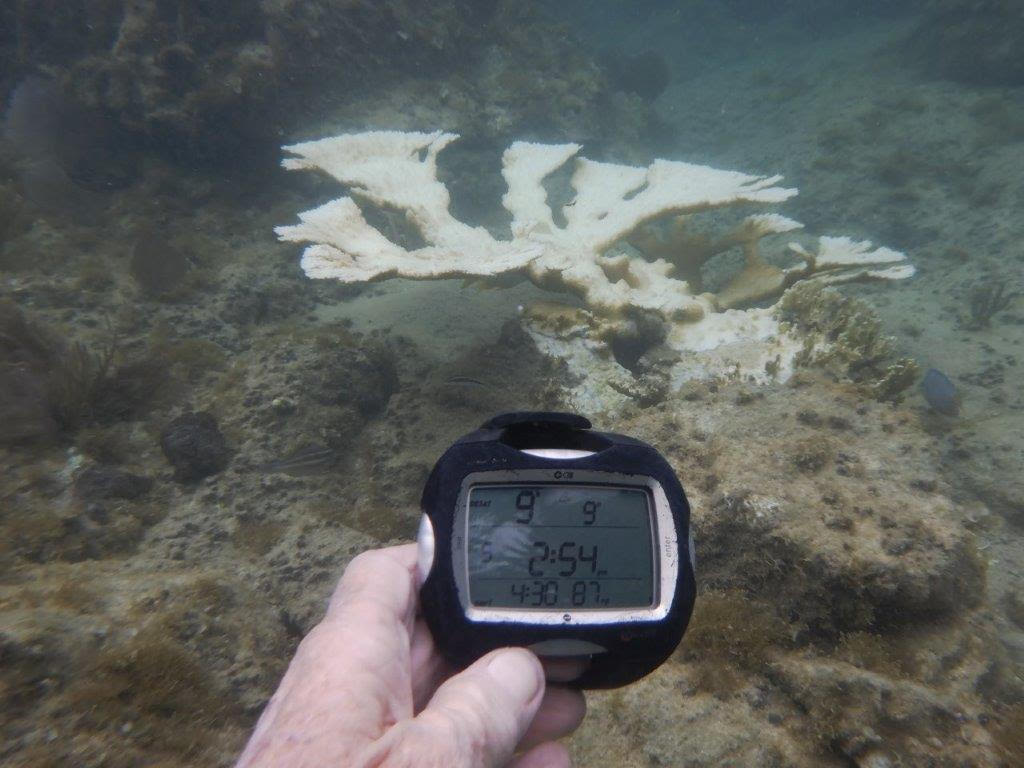
St. John tour guide Pam Gaffin has spent much of a lifetime taking visitors on snorkeling tours around St. John, diving its reef sites, and volunteering in efforts to protect marine life. She’s seen a lot of stressed coral, but she was not prepared for what she found this month in Hurricane Hole’s Borck Creek.
“Close to 80 percent of the elkhorn are white,” she said. So are a lot of star coral and brain coral.
That’s a clear indication of bleaching, a condition that weakens coral and can lead to death.
“This is really shocking,” Gaffin said, especially since the reef at Hurricane Hole has always been very healthy and is one of the few in the territory that seems not to have been infected by another coral malady, Stoney Coral Tissue Loss Disease.
The bleaching, she said, started about two weeks ago and progressed to full-blown in a startlingly short time.
“It went from a little pale to absolutely stark white,” Gaffin said. “Why this reef went is a total shock. More data is what’s necessary to find out what’s going on.”
The site is an anomaly, according to local marine experts contacted by the Source. But it may also be a harbinger.
So far, they have not seen widespread bleaching, the likes of which has devasted coral in Florida this super hot summer. But that is likely to change if-and-as territory waters continue to heat up since warm water is the primary reason for bleaching.
Bleaching occurs when the algae that live inside coral and provide it food and give it its color become toxic to the coral for some reason. The coral then expels the algae, ridding itself of the toxin but also losing the color and the nourishment.
In a cooperative effort with NOAA (the National Oceanic and Atmospheric Administration,) local government and the University of the Virgin Islands have just completed an extensive, two-week survey of reefs around St. Thomas and St. John, monitoring a wide variety of things from the prevalence of SCTLD to the number and size of other marine life frequenting reefs. Such surveys are conducted every two years.
“We did see the start of paling,” said Matthew Warham, the coordinator of the Coral Reef Initiative at the Department of Planning and Natural Resources. Teams of divers surveyed 287 reef sites, but Warham could not say immediately whether Borck Creek was one of them.
A similar survey was conducted in June around St. Croix, but the water was cooler then and there were no signs of bleaching.
Given the situation in Florida — where marine interests were taken by surprise by mass bleaching about six weeks ago — Warham said stakeholders in the islands have been proactive in monitoring for it.
“Luckily we’ve had a little bit more time to prepare,” he said.
UVI professor Marilyn Brandt explained bleaching is a stress response. “There could be tons of things” that trigger it in a small-scale situation like what Gaffin saw at Hurricane Hole, including exposure to chemicals, low water flow that allows excessive sunlight to get to the coral, or even water that suddenly becomes too cold.
But the risk of mass bleaching is usually due to warm waters, Brandt said.
“Right now we’re kind of at a tipping point,” she said. If surface water temperatures get above 30 degrees Celsius (86 degrees Fahrenheit), there is a danger of mass bleaching, “and we’re right at that line.”
She and Warham both said a lot is riding on whether the water temperature continues to rise or if storms show up in the coming weeks and months and cool things down.
Barring a cool-down, Warham said the territory may reach alert level two in September or October, and it will activate its mitigation plan. That may mean that coral nurseries are moved from warmer waters to cooler, perhaps deeper waters or, if possible, onto shore into cool facilities. It could also include shading corals. A key part of the plan is educating the public about the importance of eliminating human stressors on at-risk coral by limiting contact with reefs.





